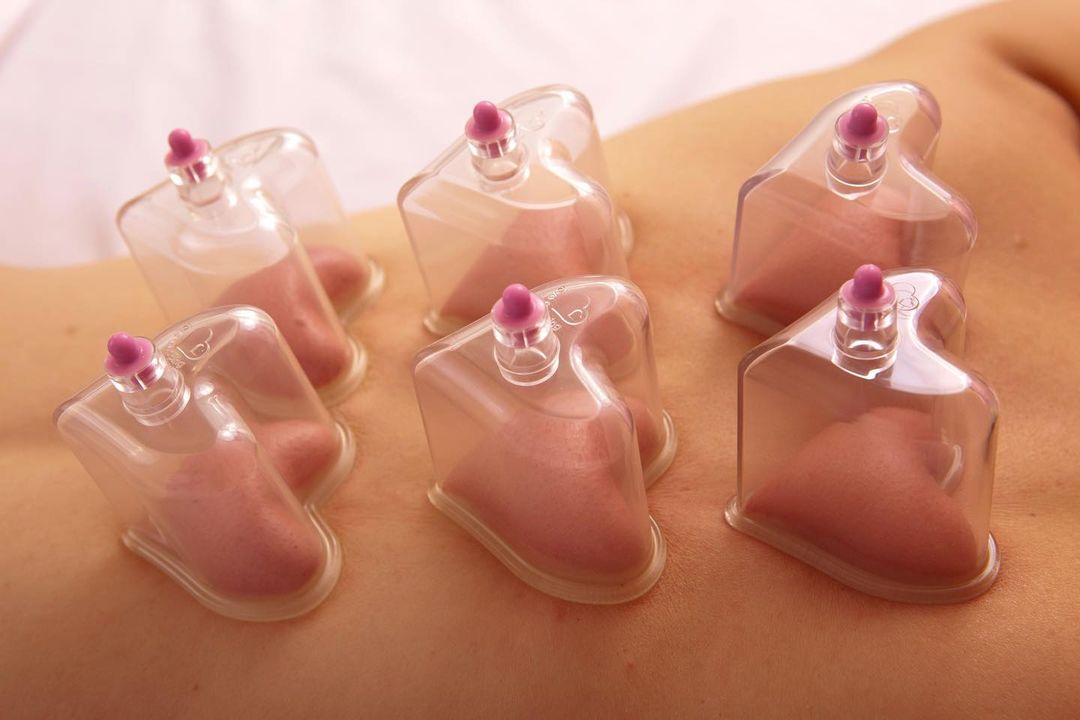Beauty...

By Hilary Sheinbaum
The first time I heard of cupping — more than a decade ago — I found myself asking a friend about the distinct red, circular marks on his back that were peeking out of his T-shirt. Before this moment, I had never heard of this Traditional Chinese medicine treatment. I was familiar with acupuncture… but cupping? Not so much. I was intrigued. Questions followed— many of them.
Did he do this himself? (No.) Did it hurt? (No.) Would these marks go away? (Yes.) And so much more.
While my friend knew most of the answers to my curious queries — the truth is: he’s no expert! To jog my memory (hey, it’s been a decade!) and dig a little deeper for information, I tapped an actual professional, Max Annis, L.Ac. MSTOM, Acupuncturist at ORA in New York City.
In case you are considering cupping for whatever reason — detoxification, relaxation, or pain relief — or just curious about the process, here’s what you need to know!
For one, tableware has no part in this process. “Cupping uses small cups made of either glass, plastic, silicone, or other materials to create suction on the skin,” says Annis. “This suction draws muscle and tissue up into the cup.” These days, modern cups have an attachment that allows a suction gun to simply pull air from the cup to easily create suction.
Liticia Reeves, who is Molly’s go-to massage therapist, says “Cupping is like a deep cleansing session that helps to create new cell growth and increase blood circulation to the area that the cups are placed. In doing so, this relieves muscle tension.”
Annis notes that traditionally, a small flame was quickly placed within the cup to remove oxygen from the inside of the cup before the cup was applied to the skin. This flame was used to create a vacuum and achieve suction. (This method is sometimes called fire cupping.) During this practice, the patient should not feel much — if any — heat from the cups themselves.
Sometimes cups are applied along with massage oil to allow the cups to continuously move along the skin, says Annis. (This is called gliding cupping.)
“Wet cupping is not usually performed, but this involves creating a small incision on the skin, then applying a cup over the incision to draw stagnant blood out of the body,” says Annis.
“A practitioner will usually use between 2 to 10 cups per treatment, depending on the type of cup used,” says Annis. A session could last as little as five minutes, or cups could stay on for up to 10 minutes. “Practitioners will sometimes leave the cups stationary or move them into different areas of tension throughout,” he says. “If gliding cupping is performed, then the cups will be moved continuously.”
This practice which originated in China, has been used for thousands of years to relieve pain, promote relaxation, and detoxify.
“The most fundamental maxim of Chinese medicine states that ‘where there is stagnation, there is pain. Remove the stagnation, and you remove the pain.’” says Annis.
“The suction created in cupping breaks up stagnation and blockage and increases circulation and energetic flow. Cupping helps relieve pain, especially in the neck and back, and anywhere where stagnation exists. Cupping loosens tight muscles and draws lymph and oxygenated blood into areas of stagnation. Lymph helps the body clear toxins, and will also help detox.”
According to Reeves, many athletes and individuals who work out religiously– enjoy the cupping process because the downtime is minimal and recovery time is quicker in-between training.
Cupping can be performed on just about anyone, with the exception of individuals with blood disorders such as hemophilia or blood clotting problems, or those with a history of deep vein thrombosis or strokes, according to Annis. He says some patients with eczema or psoriasis should also forgo cupping. (Speak to your doctor before booking an appointment.)
Cupping is performed by a variety of professionals, including physical therapists, chiropractors, physicians, and acupuncturists like Annis and Reeves. “Cupping is practiced and taught extensively in acupuncture school,” he says.
One tell-tale sign of cupping is the circular red marks (or sometimes dark marks) due to blood being drawn up into the cup. “These marks are targeted to trigger point areas and acupuncture channels,” says Annis. “The darker the mark, the more stagnation exists in the area, and the more blood, toxins, and lymph will be lifted up into the area.”
Over time, and multiple treatments, Annis says the marks will lighten. The color change signals that circulation and detox has increased in the area. “These marks can last anywhere from a couple of days to a couple of weeks,” says Annis. Though in most patients they will fade completely within a few days.
Hydrate! “This helps the body flush any toxins,” says Annis. “It is also important to keep the areas that were cupped warm and dry as much as possible for the following 24 hours.” And lastly, after a shower: be sure to dry off completely and not leave any cupped areas cold and damp.
Depending on the level of stagnation, treatment should continue either weekly, bi-weekly, or monthly, says Annis. It’s also important to know as a general rule, cupping marks need to fade completely before cups can be reapplied.
___________
Liticia Reeves is a licensed massage therapist who has practiced for 17 years. She is Molly Sim’s go-to for cupping and massages. You can contact Liticia for more information here.
Max Annis, is an Acupuncturist at ORA in New York City. You can find out more information about ORA here.